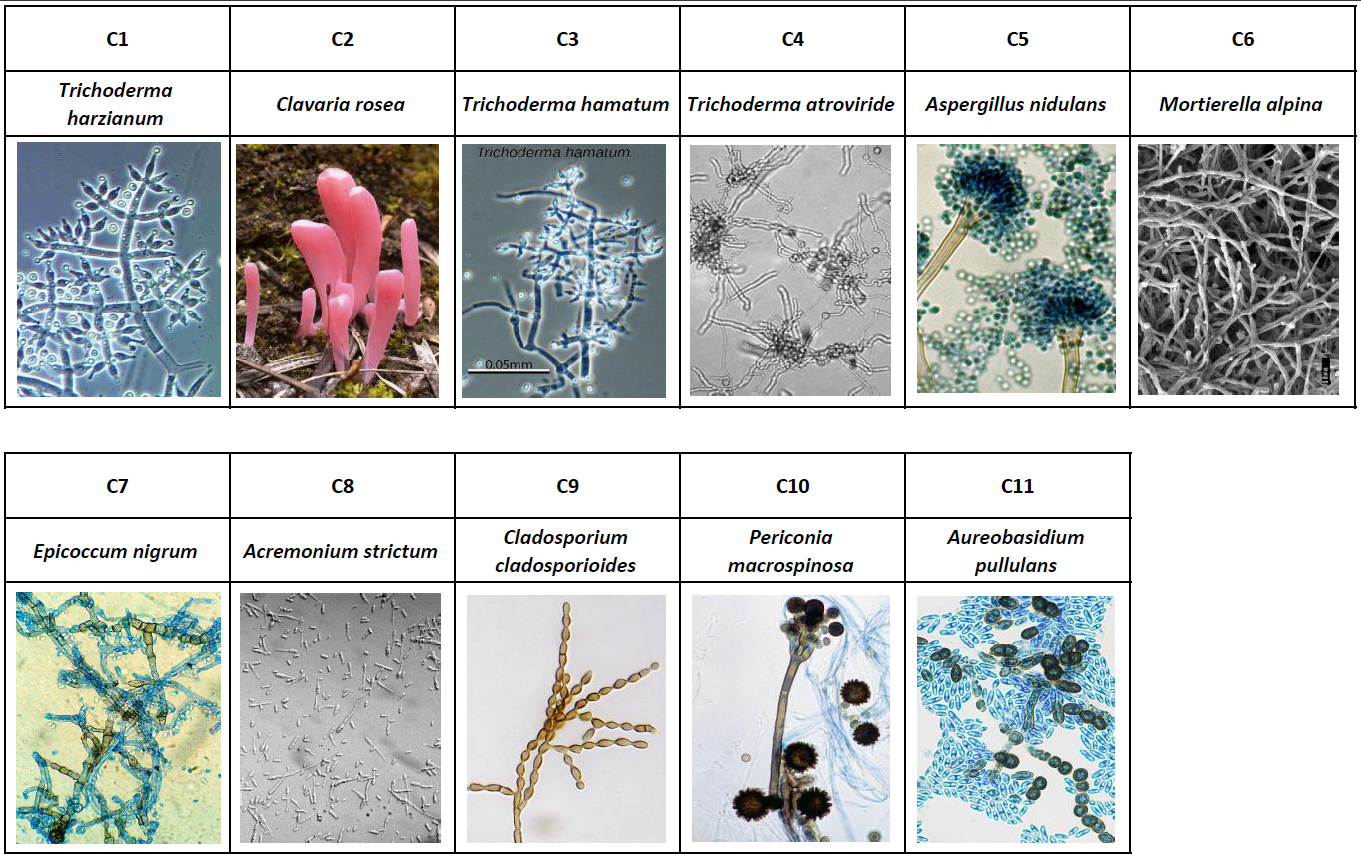1) Introduction :
This article is based on a study 1 , published in March 2023, which aims to analyze food preferences and the impact of the consumption of springtail Heteromurus nitidus (below) on fungal populations, particularly belonging to phytopathogenic species.
I warmly thank Sandrine Salmon , engineer in soil ecology at the National Museum of Natural History, co-author of this study to whom I submitted the draft of this article. She was kind enough to read it again and annotate it so that my popularization work best respects the approach and the spirit that accompanied her team's research.
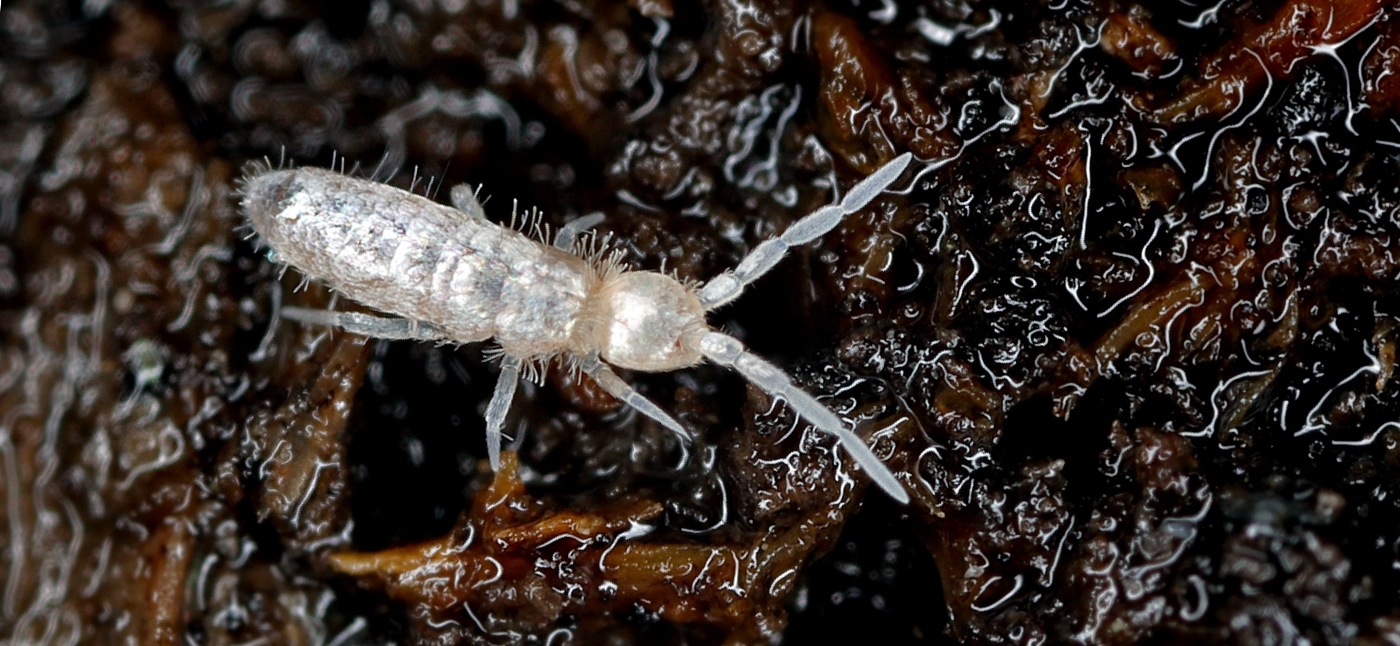
An entomobryomorph of the family Orchesellidae, Heteromurus nitidus is a widespread species that evolves in the litter ( epidedaphic ). Its body devoid of pigmentation is covered with scales rounded at their ends. Variable in color, from pale brown to whitish, its size is around 3 mm in adulthood. One of the main food resources of this collembola are fungi, but it can also consume terrestrial microalgae, bacteria, fragments of dead leaves or the droppings of other soil invertebrates.
The team that carried out this study sought to see to what extent Heteromurus nitidus could have a selective palatability, between phytopathogenic fungi (harmful to plants, and in particular crops) and non-pathogenic (harmless or beneficial). For these purposes, two pathogenic fungi were targeted: Zymoseptoria tritici and Fusarium graminaerum , respectively responsible for wheat septoria and fusarium ear wilt.
2) Diseases :

Septoria wilt (above left) is a disease that attacks the leaves on which it manifests itself by the presence of pale yellow oval-shaped spots (symptoms of chlorosis) which evolve towards a brown color revealing necrosis of the leaves. cells. On the attacked parts, tiny black balls called pycnidia form which are vectors for the spread of the disease. The latter can cause productivity losses of around 40%, because the necrotic leaves no longer properly ensure the photosynthesis necessary for the growth of the plant. During harvest, leaf residues fall to the ground and contaminate the young shoots of the following crop, from the start of their development.
Fusarium wilt (above right) is a fungal disease caused by Fusarium that lives in the soil or on plants. Fusarium is a genus of ascomycete fungi * which includes many species responsible for diseases that manifest themselves on various parts of the plant, from its roots to its stems and leaf tips. Heat and humidity favor its development. The manifestation of the disease presents the appearance of a plant that dries up and its evolution ends up causing it to die. Indeed, the development of the fungus, within the very tissues of the plant, obstructs the channels through which the sap feeds its aerial parts. Fusarium wilt can damage many crops, such as tomatoes, courgettes, melons, potatoes and cereals, to name but a few. As this fungus resides in the soil, it contaminates almost all the plants that are grown there.
* Ascomycetes represent a vast division of fungi, within which we find species that are very useful to humans, such as the yeasts used in baking, brewing and winemaking or the penicilliums used in the manufacture of cheeses or antibiotics. We also find, in this family, edible mushrooms such as morels or truffles. This group also includes phytopathogenic molds and fungi.
3) Answers from agrochemicals :
Agrochemicals have developed treatments to fight against septoria, but the molecules used ( azoxystrobin, mancozeb, maneb, ziram, myclobutanil, etc.) have an impact on non-pathogenic fungal populations or on soil fauna. On the other hand, there is no treatment allowing the eradication of Fusarium wilt. Crop rotation, uprooting, burning contaminated plants and mulching the soil to prevent the wind from spreading the fungus spores seem to be the most effective means.
In addition to chemistry, the selection of varieties is an alternative which is the subject of constant research by the major seed companies ( DuPont Dow, Bayer and Syngenta, etc. ) which offer seeds modified to be more resistant but which at the same time have been sterilized, which generates a total dependence of the users.
It should not be ignored that the use of such seeds also presents a threat to biodiversity, relative to a risk of the gradual disappearance of local seeds, proportional to the market shares won by seed companies Finally, this situation also raises a question of ethics in relation to the industrial property of seeds which amounts to a stranglehold by these large groups on the food resources of humanity.
Note on seeds : A law that came into force on June 11, 2020 authorizes gardeners to sell or buy "peasant" seeds ( seeds taken from a farmer's harvest for later sowing) provided that they are not listed in the "French official catalog of plant species and varieties".
We can, in this regard, cite the example of Kokopelli , an association based in Ariège (France)which fights to offer free of rights and non-sterile seeds, with the aim of preserving biological diversity. This association lost two lawsuits in 2008 against the Ministry of Agriculture and a group of seed companies. It is interesting to look at the reasons and arguments developed by each party, the details of which can be accessed via the following link: https://blog.kokopelli-semences.fr/2017/05/retour-sur-un-proces -lost/
4) Prerequisite to the study :
I will not return here to the processes of organic decomposition evoked in the chapter Organic decomposition of this site, if it is only to underline the crucial role which fungi play, because of the space which they occupy at the interface between soil and decaying organic matter. Indeed, their action can be beneficial, in that they make nutrients accessible to plants and can help them fight against abiotic stress, generated by changes in environmental conditions (drought, frost, excess water, bad weather) . climatic conditions…) or biotic stress, resulting from the harmful action of other living organisms, as is the case during a fungal attack.
However, not all fungi are beneficial for plants, the two species which are the subject of the study indeed represent a threat to cereal crops and in particular those of wheat.
As mentioned above, phytosanitary treatments have been developed, but they cause collateral damage because they are not sufficiently selective to spare non-target beneficial auxiliary populations (plants and animals) which paradoxically leads the targeted pathogenic fungi to develop increased resistance , much like bacterial strains of various diseases that develop resistance to antibiotics.
Consequently, a vicious circle is established which leads farmers to increase the dosages of antifungals, to which is added the need to use chemical fertilizers in addition to the role that microorganisms and soil fauna can no longer perform, affected by these treatments ( Pelosi et al, 2013 ) 2 . This process can eventually lead to soil sterility and biological death.
In this context, springtails, through their food choices, turn out to be both regulators/disseminators of fungal and microbial populations. Studies have already established the role that Folsomia candida could play , frequently mentioned on this site (read Collembola bioindicator ) and whose consumption of Fusarium helps to limit its proliferation.
5) The study :
The researchers conducted their study, both long-term and short-term, in the laboratory. They proposed Heteromurus nitidus fungal pairs (pathogenic/non-pathogenic) based on eleven beneficial species, compared to the two pathogenic species mentioned above. The surveys not only focused on the food preferences of the springtail, but also on the impact of its consumption on its own development and on the evolution of the populations of pathogenic fungi consumed. The starting idea being to know if Heteromurus nitidus was likely to be a beneficial biological auxiliary to crops.
The choice of eleven non-pathogenic fungal species was established from a list of the fungi most frequently found in wheat crops. It is on this basis that their selection was then made according to their different beneficial effects on crops (recycling of nutrients, regulation of pathogens, etc.).
Below, the non-pathogenic fungi selected and their correspondence with the abbreviations used on the abscissa of the following graphs.
6) Cultivation of mushrooms for use in experiments :
I pass quickly on the device implemented for the culture of the mushrooms, if it is not to specify that the mode of development and the growth of each one of the eleven species were integrated, in order to ensure a homogeneity of the distributions of populations on the “circular portions of agar” ( 10 mm in diameter by 3 mm in height ) which carry these populations, identified on the diagram below by “pathogenic” and “beneficial”.
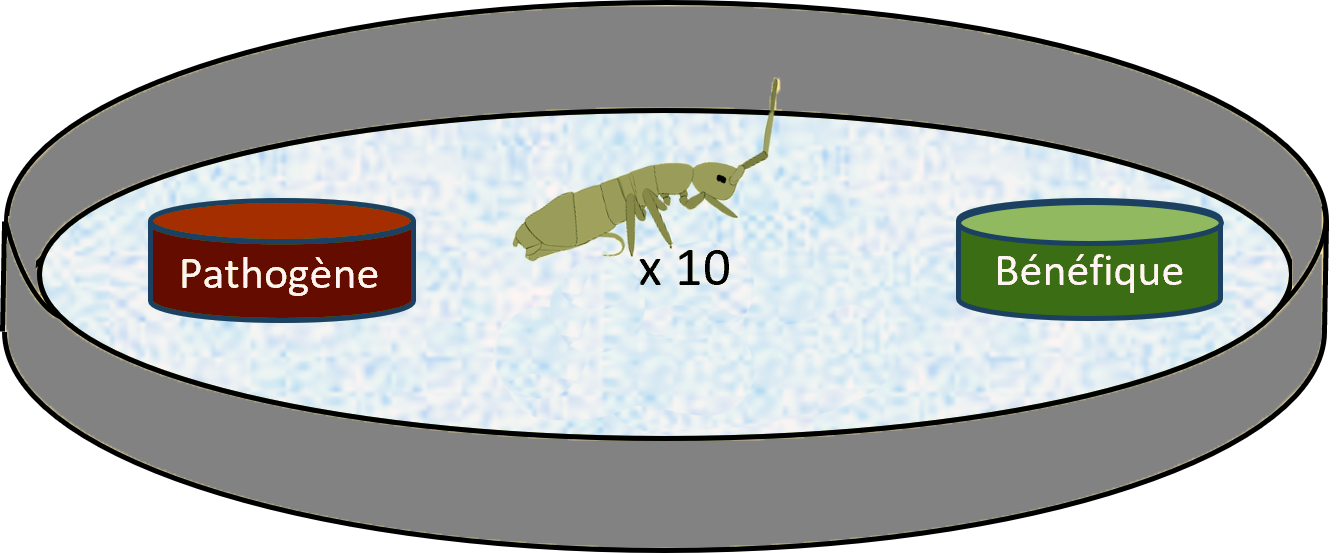
The initial cultures were carried out on the basis of species from the collection of fungal species of the National Museum of Natural History in Paris and cultured for two weeks under controlled conditions (t°=25°C.) on a specific support called “Mandel's medium” .
Subsequently, the phase of fungal colonization in the Petri dishes was carried out in the dark at a temperature of 4°C, for a maximum of two weeks. The eleven non-pathogenic fungal species were then paired with each of the two pathogenic fungi, which corresponds to a total of 22 trials.
NB: With regard to the short-term choice experiments, aimed at highlighting the food preferences of Heteromurus nitidus , the researchers carried out twelve repetitions (12 boxes) in order to ensure that they obtained a sufficient data set. for performing relatively powerful analyses.
The positions of the ten springtails introduced in the middle of each dish were recorded every ten minutes during the first half hour, then every thirty minutes for three hours. It is the number of individuals on each of the two mushrooms after 210 minutes that will be analyzed.
The long-term experiment (ten weeks) aimed to quantify the consumption of pathogenic fungi, by observing the reduction in the surface occupied by the mycelium of fungi resulting from grazing by springtails.
The second objective was to assess the effect of long-term consumption of pathogenic fungi on the dynamics (reproduction, mortality, growth, etc.) and size of springtail populations that fed on them. It required setting up three separate conditions for each pathogenic fungus, repeated 10 times each.
Quantitative surveys of springtail populations were carried out under a binocular magnifying glass, at a frequency of three per week. They took into account adult or subadult individuals, juveniles, as well as eggs, exuviae (molts) and dead individuals that were removed weekly. For measurements relating to mycelial coverage, which are difficult to quantify by visual observation, the researchers used image analysis software .
7) Experiences of choice :
At the end of the 210 minutes that lasted the first experiment to assess the food preferences of Heteromurus nitidus with Zymoseptoria tritici , the researchers established that of the 1322 individuals used, 1092, or 82.6%, had chosen one of the two proposed fungi.
For the experiment with Fusarium gramineerum, carried out according to the same protocol, out of the 1322 individuals used, 923, or 69.7%, also showed a preference for one of the two fungi proposed.
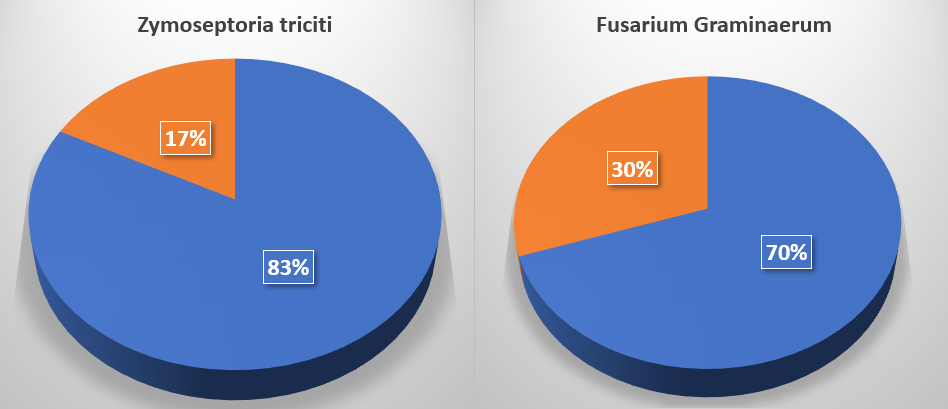
These initial findings attest that Heteromurus nitidus shows marked food preferences when confronted with different fungal species. But it still remains to be determined which species are its preferences: pathogenic or beneficial?
To do this, the researchers used statistical tools to process the readings taken during the study. They obtained selective graphic representations on which all the proposed fungal species appear.
Preliminary remark :
For the sake of readability, the two histograms proposed below are very simplified adaptations of the graphic representations of the original study which are presented in the form of "boxplots" bearing statistical data in the form of quartiles. I redacted the data ranges to retain only the median values. Aware of the approximations induced by such an approach, it seemed to me that the resulting histograms nevertheless made it possible to illustrate with enough clarity the food preferences of Heteromurus nitidus.
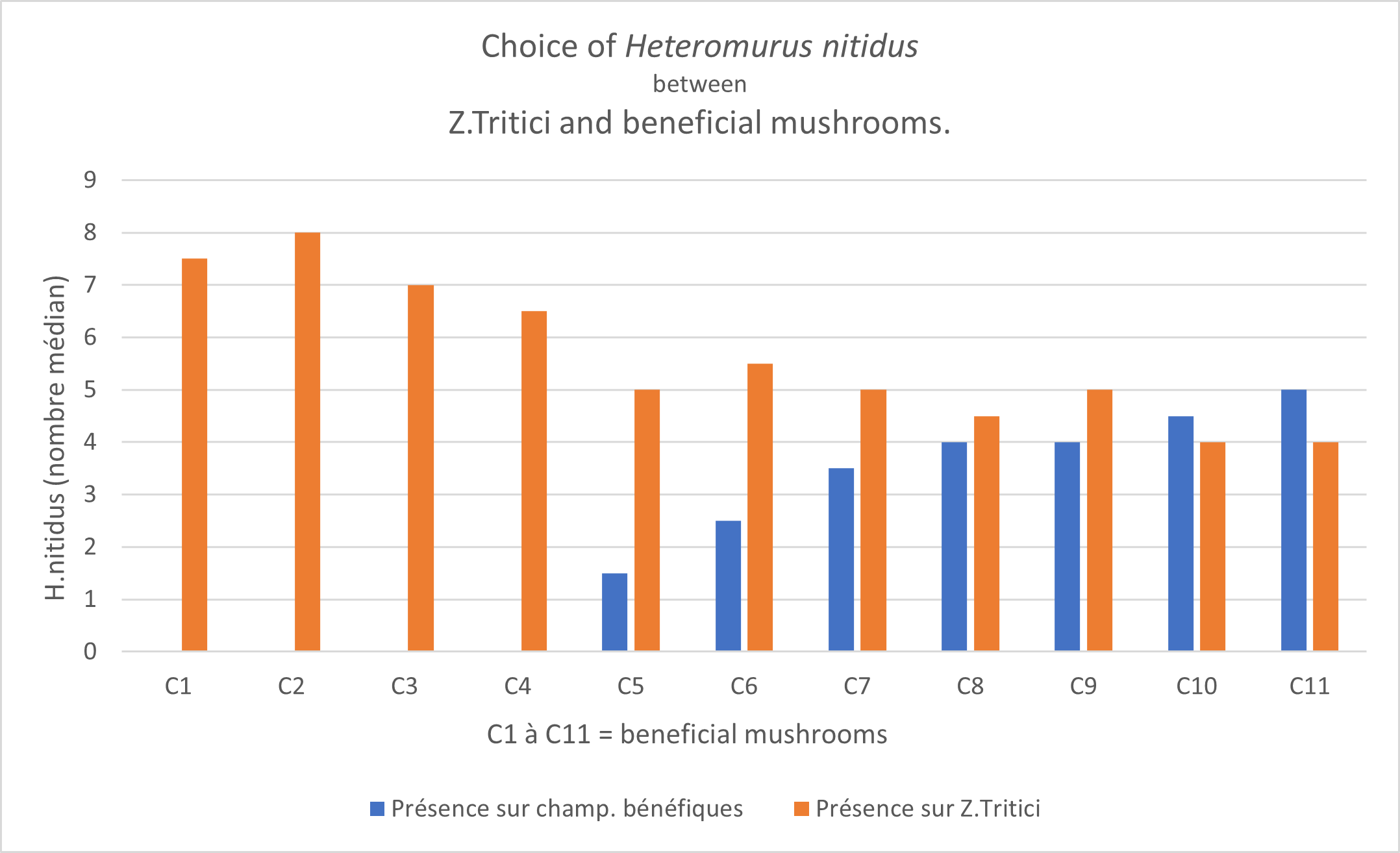
Comment :
It can be seen that Heteromurus nitidus shows a majority preference for the pathogenic fungus Z.tritici in the presence of C1 to C4. In the presence of C5 to C7, the springtails remain more numerous on Z. tritici than on the beneficial fungi but in a less marked way. From C8 to C11, the study shows very small deviations which do not make it possible to highlight a preference between Z.tritici and beneficial fungi.
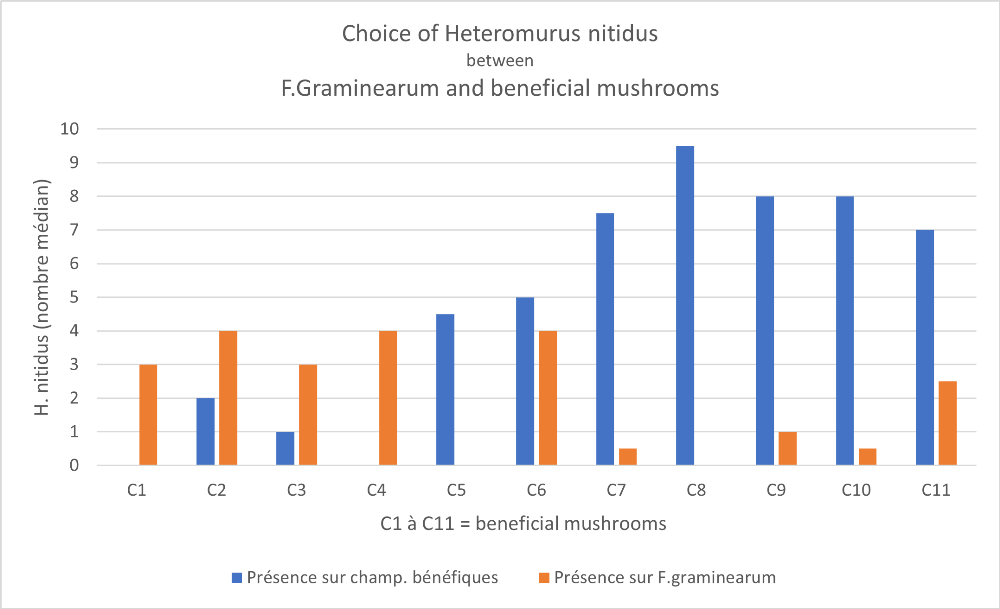
Comment :
For the experiment putting Heteromurus nitidus in the presence of Fusarium graminearum , and the eleven non-phytopathogenic fungi, the results show a preference of springtail for the phytopathogenic fungus with respect to C1 to C4 and no preference established with respect to C6. On the other hand, the beneficial fungi C5 and from C7 to C11 were preferred to Fusarium graminearum, in particular for C7 to C11 with clearly marked proportions.
Conclusion :
We can therefore already conclude that Heteromurus nitidus shows a significant preference for Z triciti, compared to a majority of beneficial fungi, and shows no preference for any of the proposed beneficial species. On the other hand, in the presence of Fusarium graminearum such a distinction cannot be established.
8) Long-term consumption experiences :
The experiment consists in measuring the induced effects of the consumption of pathogenic fungi on springtails. To do this, the researchers introduced thirty adult or subadult springtails into three distinct media:
- Medium "1" : Culture of pathogenic fungus on Mandel medium*.
- Medium "2" : Mandel's medium uncolonized .
- Medium "3" : Sand substrate alone.
* Mandel's medium (MM) is a mixture that feeds and promotes fungal cultures but is hardly consumed by springtails. It is composed of determined proportions of various elements ( glucose, ammonium sulphate, monopotassium phosphate, calcium chloride, urea, yeast extracts, agar and trace elements, etc.)
Note : Medium "3" makes it possible, by comparing it to mediums "1" and "2", to ensure that the growth observed within the latter is indeed the result of the diet and not of possible reserves constituted by the collembola before the start of the experiment. This comparison also ensures that spawning is not the result of environmental stress. The comparison between medium “2” and medium “3” makes it possible to evaluate the growth due solely to the fungus and not to the agar (Mandel medium).
Survival of springtails after consumption of mushrooms pathogens :
The insignificant character, for the neophyte, of the variables relating to the consumption of mushrooms, led me to propose no figures in this transcription. I am content to list, without detailing them, the most significant elements that emerge, conscious of being, here again, simplistic, without however deviating too much from the lessons that can be drawn.
Significant differences were measured between the conditions of medium “1” and “2” for each of the two pathogenic fungi. At the end of ten weeks, the readings highlight the following elements:
- The number of eggs laid on the pathogenic fungi is greater than those laid on the substrate (MM) not colonized (agar without fungus).
- The number of exuviae produced (which is an indicator of springtail growth) is greater in the presence of pathogenic fungi than on medium “2” and “3”.
- The number of juvenile springtails listed is significantly higher in the presence of the two pathogenic fungi than on medium “2” and “3”.
- The number of adults and the total number of springtails is higher in the presence of the two pathogenic fungi.
- The number of dead springtails at the end of ten weeks is much lower in the presence of pathogenic fungi than on medium “2” and “3”.
It can be concluded that Heteromurus nitidus develops and reproduces without difficulty, when it consumes either of the two pathogenic fungi.
9 ) Lessons and questions :
Some findings from this study:
Within the beneficial fungal families studied, the researchers noticed a lack of palatability of Heteromurus nitidus for certain beneficial fungal species which showed a strong chitinolytic activity (production of the enzyme chitinase which is involved in the process of degradation of chitin). This chitinolytic activity can make these fungal species biological control agents against phytopathogens (fungals, insects and nematodes). The springtail exoskeleton, made up of chitin, could also justify Heteromurus nitidus abandoning these non-pathogenic fungi.
It is also shown that the pigmentation of fungi attributed to the presence of melanin is not a determinant in the preferential choices of springtails.
In the majority of the cases studied, the fungus which presents the strongest attraction for Heteromurus nitidus is the pathogen Zymoseptoria tritici. This preference can be explained by the fact that Z. tritici has a high nutritional value for springtails (favorable to the development of populations) and that it should not or hardly excrete metabolites (organic compounds) which would protect it against grazing.
Some questions raised :
The study carried out in the laboratory (in vitro) establishes that Heteromurus nitidus can, by feeding, reduce the aerial mycelium cover of the two cereal pathogenic fungi.
- The well-marked appetite for Zymoseptoria tritici suggests that this preference could be confirmed in the field.
- The boxes analyzed for Fusarium graminearum are on the other hand much less significant to consider a convincing result in the field.
Paradox ? : It seems that there may be, in some cases, a "critical density" of springtails likely to reduce the surface occupied by the mycelium of the pathogen. It is, in fact, mentioned according to the scientific literature, that a limited grazing of the mycelium can, under certain conditions, favor its growth.
12) Conclusion :
Studies are still necessary to verify the results obtained, in particular to validate them in an open configuration (in the open air). The multiple fungi/collembola interactions that induce palatability or repulsion need further investigation. It would also be useful to carry out this type of study with other species of springtails and to approximate, as much as possible, real conditions, by making more use of experiments whose preparations include the matrix of crop soils.
There are many reservations, but the results of this study, reinforced in that they confirm previous studies, suggest encouraging prospects for the regulation of pathogenic fungal populations, in particular here on the fungus responsible for septoria.
Reflection :
If the idea of introducing springtails to protect crops from attacks by certain fungi seems attractive, it comes up against the difficulties that there would be in massively raising these springtails.
It would be more plausible to find a way to attract springtail populations already present to contaminated areas. The track of aggregation pheromones could be explored for these purposes (read the article: Chemical communication of springtails )
Sources :
1: “Dietary preferences of Heteromurus nitidus (Collembola) among wheat fungal communities: Implications for bioregulation of two widespread pathogens”
Thomas P. Bourgeois a , Frédéric Suffert b , Gerard Dury a , Gwenola Biau a , Sandrine Lacoste c , Soizic Prado d , Jöelle Dupont c , Sandrine Salmon a
a-National Museum of Natural History, CNRS, Living Adaptations Department, UMR 7179 MECADEV, 1 avenue du petit-chateau , 91800 Brunoy, France
b-Paris-Saclay University, INRAE, UR BIOGER, 91120 Palaiseau, France
c-National Museum of Natural History, CNRS, Origins and Evolution Department, UMR 7205 ISYEB, 12 rue Buffon, 75005 Paris, France
d-Sorbonne University, National Museum of Natural History, CNRS, Living Adaptations Department, UMR 7245 MCAM, CP 54 57 rue Cuvier, 75005 Paris, France
Link: https://www.sciencedirect.com/science/article/abs/pii/S0929139323000951
2 : “Reduction of pesticide use can increase earthworm populations in wheat crops in a European temperate region”
C. Pelosi a , ∗ , L. Toutous a , F. Chiron b , F. Dubs c , M. Hedde a , A. Muratet d , J.-F. Ponge e ,
S. Salmon e , D. Makowski f , g
Link: https://www.sciencedirect.com/science/article/abs/pii/S0167880913003411
